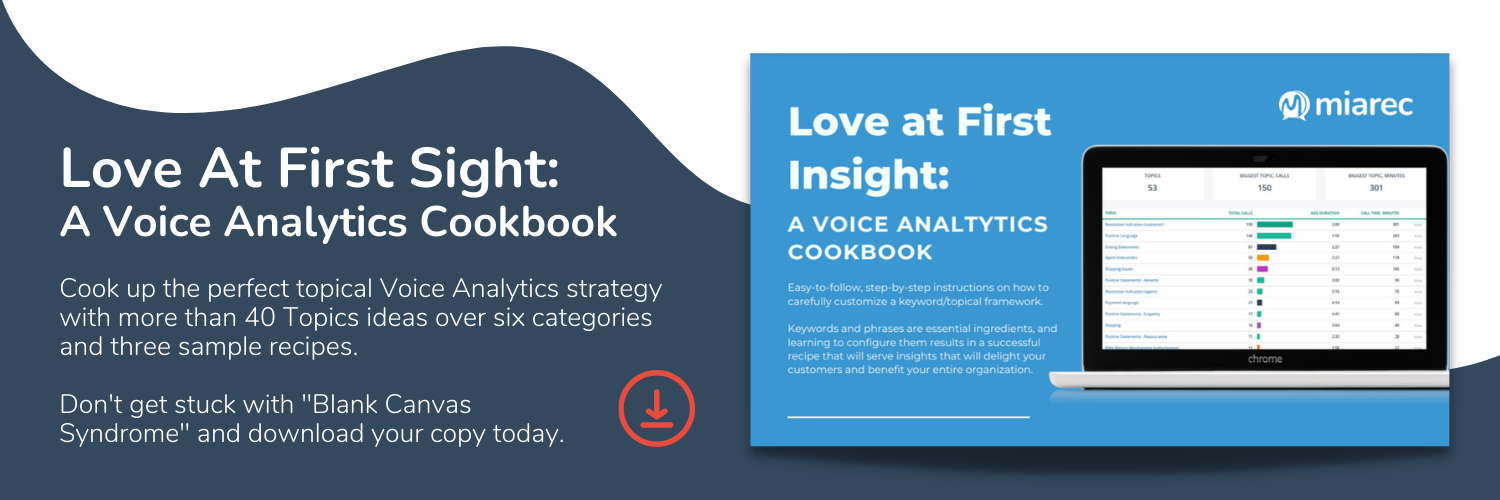Topic & Sentiment Analysis in Contact Centers: Definitions, Use Cases, Benefits
CX Today | MiaRec
John Ortiz, MiaRec's Technology Sales Manager, joins Charlie Mitchell of CX Today for the CX Today discussion to talk about:
* Definitions for topic and sentiment analysis
* Contact center use cases and and benefits of both
* Implementing topic and sentiment analysis solutions
During the interview Charlie and John explore the benefits and real-life applications of these analytics techniques, showcasing their potential to transform customer experiences and agent performance. John provides insightful examples of how MiaRec's solutions are enhancing agent training, customer satisfaction, retention, and compliance adherence. He also offers valuable advice for setting up successful topic and sentiment analysis initiatives. The conversation highlights the power of using data-driven insights to improve overall contact center operations.
To view the the full interview, please watch the video below:
Read the full interview transcript below:
Charlie: Hello and welcome to CX today. My name is Charlie and I'm delighted to be joined by John Ortiz, Technology Sales Manager at MiaRec. John, thank you very much for joining us today. How are you doing?
John: Of course! I'm doing great, super excited to be here and really appreciate it. How are you?
Charlie: Yeah. All good. I'm just excited to talk to you today about topic and sentiment analysis and how they can possibly benefit contact centers. This is a topic that I am enthusiastic about. I love the kind of the applications of conversational analytics in the contact center. Maybe it's somebody who's new to the field, can you explain kind of the concepts of topic and sentiment analysis and how they work?
John: Absolutely! Put simply, topic analysis gives you the ability to categorize your phone calls. Why is this important? Contact centers are normally fielding thousands of calls per day. Being able to categorize or label those calls is crucial in helping you understand what is being talked about in your contact center. Without topic analysis, I would say your contact center is kind of just an ocean of disorganized, nonsensical data. Topic analysis is going to help you with grouping calls together based on what was discussed on the call. For example, if a customer calls into to complain, which we hope not, but it happens, this call might be labeled as a customer complaint call. Or if a customer calls in and just needs help with something that might be labeled as a customer service call. Topic analysis does exactly what it sounds like it will do. It groups calls together by topics that were discussed on the phone calls. Also, it's important to note that in most cases, topics can be custom configured by the end user. You can build out topics that are relevant to your business or your contact center.
That's topic analysis and then sentiment analysis, on the other hand, is a tool that uses natural language processing to analyze the text or the transcription of a phone call to determine the phone call’s emotional feeling or sentiment. Traditionally, sentiment analysis will group your phone calls into one of three categories: either positive, neutral, or negative. Phone calls with a positive sentiment indicate things like satisfaction, enthusiasm, or appreciation. Neutral sentiments calls will suggest a lack of strong positive or negative emotions. For example, a phone call where someone just exchanges basic information. Negative calls usually convey frustration, dissatisfaction, or disappointment. Classifying calls into these categories is critical because it provides businesses with a quantitative measure of the overall tone of their customer interactions. These are extremely valuable insights into customer experience. It enables businesses to identify trends so they can make informed decisions and then take targeted actions to enhance customer experience satisfaction and improve overall performance of the contact center. Long-winded answer there for you on what those are.
Charlie: I think that was a great explanation of what both of those applications that are in the contact center. As you mentioned, there are many benefits to each, but I think the next best question to ask you is, can you give me some examples of how both topic and sentiment analysis are used in real life contact center situations?
John: I'll try to keep this one not as long-winded, because there's so many use cases or real-life applications for both topic analysis and sentiment analysis. I could go all day. One of my favorite use cases for topics is you create the name of the topic first. One of them I like to use all the time is called lack of knowledge. This topic is extremely valuable because it can help you improve several areas of your contact center. One, it can help you with upskilling your staff. Two, it can help you increase first call resolution. It can help you improve customer experience and lower average handling time. All of that with one topic. I'll explain. The purpose of the topic, lack of knowledge, is basically to categorize all your calls where your contact center agents don't know how to help a customer. For example, if your agent says something like, ‘I don't know’, or ‘beats me’, or ‘let me ask my manager’, those calls will immediately be categorized as "lack of knowledge" calls. This data is absolute gold because you have a treasure trove of kind of perfect training opportunities. You listen to these calls, you identify the situations where your agents are unsure of how to help your customers, and then you train your agents on how to properly handle these situations moving forward.
So what have you done with this topic? You've upskilled your staff and chances are if one agent doesn't know how to handle a certain situation, others don't either. Now your agents can handle this situation moving forward so they can solve this same issue in a single phone call. You've increased your first call resolution and again, in that same breath, if someone calls in again with that same issue, your team is ready to handle it. You're basically providing an improved customer experience. Lastly, now your agents don't have to put callers on hold anymore while they're trying to figure out that issue so you're lowering your average handling time (AHT). All of that was just a single topic. That's one of my favorite ones for sure.
Another topic or example of the use case, one of our current clients is using this right now, is a topic called "permission to charge credit cards". This gives you the ability to keep track of verbal agreements. I've experienced this or experienced this same situation many times when I was an account executive. Oftentimes what happens when a customer is purchasing something from you, they will ask you for a post-dated or a delayed payment. For example, here's my credit card number but don't charge my card until next Tuesday. What happens is next Tuesday comes along, the card is charged, and then that same caller, we'll just call him Joe, they'll call in and say, ‘why did you charge my card? I didn't authorize this.’ This literally happens all the time. Thankfully, because I have my topic called permission to charge credit card, we can easily locate that call to verify that Joe did in fact authorize us to charge his card today. This is a super helpful topic. It again allows us to keep track of verbal agreements and it can absolutely aid us with dealing with any type of customer complaints.
One more topic use case. You can use topic analysis to help with one of the oldest and never-ending problems that exist in a contact center which is a contact center agent retention. It's a revolving door. I read a report recently by Contact Babel that said the average annual attrition rate of a contact center agent is around 30%. You're losing almost a third of your contact center agents every year. When I worked in a contact center, I did for years, I've been in that situation where January 1st there will be one set of 10 people on my team and then by December 31st the entire team is different. Anyone who's ever worked in a contact center can attest to this. I strongly believe that one of the main reasons why agents leave contact centers is because they don't feel appreciated. We can use topic analysis to help with this, too. Basically, what you do is set up a topic and you call it something like resolution indicators. Anytime one of your customers says something like, ‘I'm happy’, or ‘I'm pleased you were very helpful’, or ‘perfect’, this will populate in the topic resolution indicators. This is super helpful or useful data. All of these calls are examples of when your agents were able to successfully help a customer or do a great job. You can use this data to give public praise to your agents when they're doing a great job. What impact does that have? Another study that I was reading recently shows that organizations with a strong recognition program have a 31% lower voluntary turnover rate than those companies without. The numbers don't lie. Using topic and analysis to identify when agents have done a great job and recognizing them for it is going to have a significant positive impact on your contact center agent retention. Those are just a couple use cases for topic analysis. Obviously, there's a lot more.
.png?width=800&height=419&name=Copy%20of%20MiaRec%20Blog%20Quote%20Template%20(2).png)
Now regarding sentiment analysis, I mentioned earlier, gives you the ability to listen to the voice of the customer, which is an extremely popular topic in business today, VOC. Every company wants to know what their customers are thinking and how they're feeling. If you know how your customers are thinking and feeling, this gives you the ability to improve your products. You can strengthen customer experience, tailor marketing efforts to them and streamline business workflows. There’s a lot of things that you can do with that information. That's why so many companies are implementing post call surveys to learn what their customers are thinking and how they're feeling about them. The only problem with the post call surveys is the data shows that only about 5% of people will stay on the line to complete them. There's really no incentive to do it. Where sentiment analysis comes in is it gives you the ability to score or grade 100% of your call volume for sentiment. Now you can clearly see exactly how many of your calls are positive, neutral, or negative. Basically, you can use sentiment analysis to replace post call surveys, this will aid you in your VOC strategy to analyze 100% of your calls.
Charlie: I think again, lots of great stuff there. I started making a list in front of me of all the benefits that could bring from increased first contact resolutions; low average handling times to increase agent retention and so many more that I can't read my own writing. There’s lots of clear benefits and I'm sure there's even more that you can have by applying some of their use cases. You said that the lack of knowledge one, by the way, I really liked. I can see the tangible benefits that brings to a content center. What other sorts of benefits are you seeing this technology bring service operations?
John: I think I unloaded all of them. There are so many benefits to topic and sentiment analysis and especially when you can use them together, too. Individually they're powerful tools if they use them just by themselves. Together, combining them, for example, you can use a topic in sentiment analysis to track and see how a certain product is performing. What you do is create a topic and make it about your new product and then whenever clients call in you mention that product, it's going to be tracked by topic analysis. You can use topic sentiment analysis together to see all the scores that are with the sentiment scores relating to that topic. That's another benefit you can use it for. You can use it to really track how your products are performing or particular services are performing. There's a lot of different benefits to effectively using sentiment analysis and topic analysis. It’s going to help you improve customer experience, improve customer satisfaction, you can use it to upskill your staff, enhance marketing efforts, increase customer retention and loyalty, it can also help you reduce churn, customer churn and, like I mentioned, increase agent retention. There are even situations where you can use a topic sentiment analysis to help you assist with compliance adherence. At the end of the day, it’s business, it's all about money, so ultimately topic and sentiment analysis is going to help you increase your revenue and increase your bottom line.
Charlie: So many more use cases for this technology just come to mind, as you say, data reduction, in the world of generative AI where you need to remove sensitive data from call recordings and the whole speech over analytics can be used for that and in topic analysis you can pick out different topics to feed your generative AI. It boggles the mind with all the possibilities you can look through the topics to see where automation goes. Fascinating stuff, but I think just talking about the practical application of these two use cases to get to the topic and the sentiment analysis What would be your advice to someone who's trying to set up topic and sentiment analysis initiatives for the first time?
John: That's a great question. I'll start with topics. Do you mean when it when someone's looking to onboard or purchase the software array setting it up?
Charlie: Yeah, exactly.
John: With topic analysis, one thing I would look for when you're looking to onboard a new voice analytics solution that has topic analysis is to make sure you have the ability to custom configure topics. Obviously, every business is different and has different products, different services, different needs. If you can't custom configure your topics to fit your business needs, then it won't be as effective. That’s one thing, make sure you can custom configure topics. When you're setting up topics, another thing I would check for is see if the voice analytics platform that you're using comes with pre-configured topics. For example, the company I work for, MiaRec, whenever one of our customers onboards our product, it comes with pre-configured topics. We think these topics are kind of applicable to any business. They can be modified or deleted. Last thing is if you're setting up topics, I would recommend that you start slow. Start with just a few topics at first and let your call volume drive what you're doing. It’s definitely better to start with just a few topics as opposed to making 20 or 30 of them and seeing what happens. Start with a couple topics and then let it expand or grow from there. With regard to sentiment analysis, one thing that I always recommend checking on is make sure the sentiment analysis being used is natural language processing sentiment analysis. In the market today you'll see two different styles of sentiment analysis. One is rule based and then one is natural language processing. With rule-based sentiment analysis you basically have to configure it yourself. You have to configure your list of good and bad words. For example, if you want the word banana to be a negative word, you have to configure it as such. With rule-based sentiment analysis, the configuration process can take quite a while. It requires constant adjusting. That’s going to lead to a lower accuracy with regard to the true sentiment score. With natural language processing sentiment analysis, this is ready to use out of the box. There's no configuration required and with natural language processing sentiment analysis, it can pick up on things like context as well. Sometimes one word can mean more than one thing. NLP can pick up on context. Just make sure the voice analytics platform you're using or onboarding is using natural language processing sentiment analysis and not rule-based. Make sure you ask the other vendor. Make sure that you can custom configure topics, check to see if that solution comes with pre-populated topics, start slow, start with just a couple topics, and make sure the voice analytics solution is using natural language processing sentiment analysis. Those are the four things I'd recommend.
Charlie: Excellent. Again, lots of really great stuff. My next question to you is why should contact center choose MiaRec? I guess you've kind of answered that to an extent through your pre-configured topics and through your use of NLP in sentiment. Could you give me the pitch for why MiaRec is the one of the best technology partners for these topic in sentiment analysis.
John: Absolutely. I would like to start out by saying MiaRec is a fantastic solution, but I wouldn't say it's hard to say one's absolutely the best because there could be one solution that makes sense for one business and one that makes more sense for another business. It depends on the use cases that they're trying to solve and the business issues they're trying to solve. If they're looking to increase efficiency by using automation, we can come in and help with that. If compliance is a big issue for them, they're looking for compliance adherence, we are a tremendous help with that. We have things like automatic data redaction, we can verify script adherence with things like auto call scoring. If compliance is a big one for you, then definitely MiaRec would be a great solution. If you're looking again, like we mentioned earlier, to really learn more about what your customers are thinking and feeling, using MiaRec NLP sentiment analysis would be a great fit. I don't really see why anyone wouldn’t want to know what their customers are thinking and feeling. That’s a really important one. Those are a lot of the features that MiaRec is really great at. Again, it depends on the use cases that you're trying to solve.
Charlie: Absolutely. I think that's a great answer as of all of your answers to my questions today. I think it’s probably a great note to end on as well. I've really enjoyed this conversation so thank you very much for coming on and talking to me today, John.
John: Awesome. I really appreciate you guys having me. I've been looking forward to this. Thank you and I hope you have a great rest of your day, Charlie. Thank you.
Charlie: Excellent. You, too, and I hope all our viewers enjoyed watching our conversation, too. Bye for now.
Share this
You May Also Like
These Related Stories

Generative AI In Conversational Analytics: Demo & Discussion [CX Today]

5 Value-Adding Conversation Intelligence Use Cases for Contact Centers




